
Appearance
The Karoo chat is 16–18 cm long and weighs around 32 gm. Its upperparts are grey, but it has a rufous patch behind the eye, and the tail is black with white outer feathers. Its underparts are white, the short straight bill, legs and feet are black and the eye is dark. The sexes are similar, but the juvenile is spotted with buff and has scaly underparts.This species is paler than the similar grey form of the female mountain wheatear, from which it also differs in having a grey rump and completely white outer tail feathers. Its larger size and all-white outer tail feathers prevent confusion with the tractrac or sickle-winged chats.

Status
This common species has a large range, with an estimated extent of 1,100,000 km². The population size is believed to be large, and the species is not believed to approach the thresholds for the population decline criterion of the IUCN Red List. For these reasons, the species is evaluated as Least Concern.Reproduction
The Karoo chat builds a cup-shaped nest of straw and leaves on the ground, usually under a bush or shrub. It lays two to four green eggs. This species is monogamous, mating for life.Food
The Karoo chat is usually seen singly or in pairs. It forages from the ground for insects including butterflies, bees, wasps, locusts and ants. Prey is typically taking in a short flight.References:
Some text fragments are auto parsed from Wikipedia.
